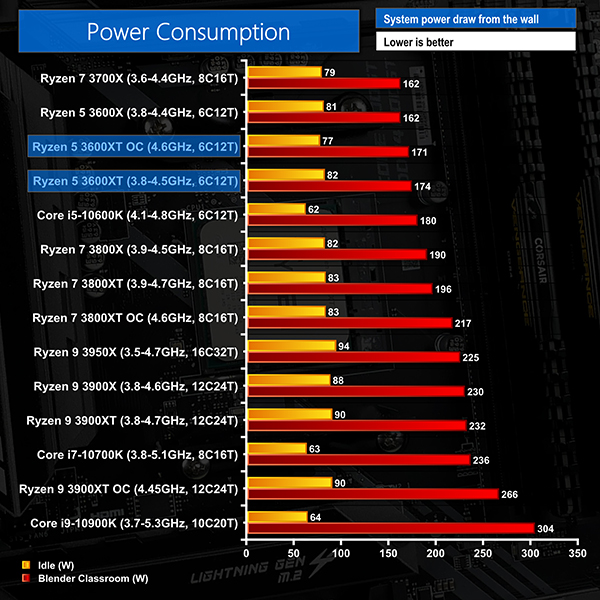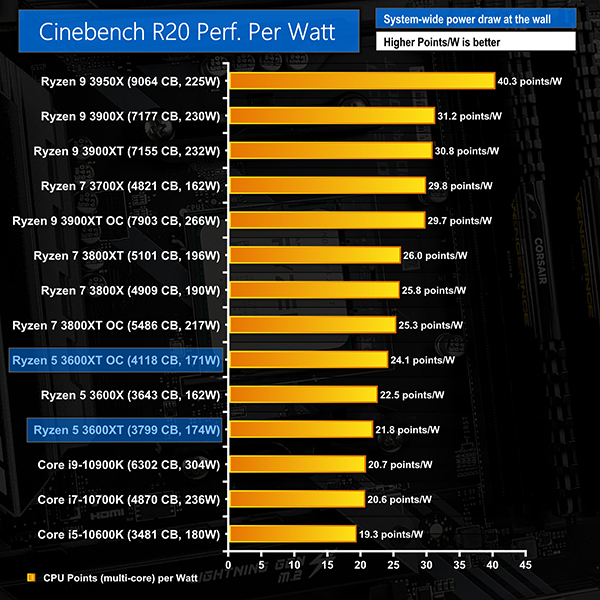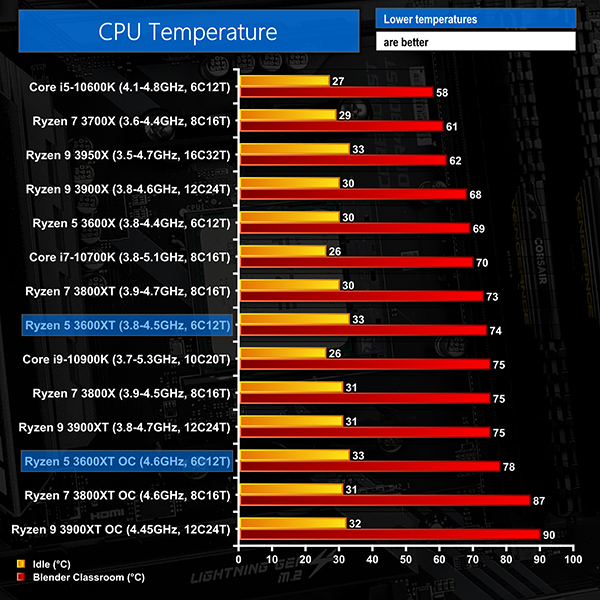We leave the system to idle on the Windows 10 desktop before taking a power draw reading. For CPU load results, we read the power draw while producing five minutes' worth of loading in the Blender Classroom rendering test.
The power consumption of our entire test system (at the wall) is shown in the chart. The same test parameters are used for temperature readings.
Power Consumption
Power draw readings are accurate to around +/-5W under heavy load due to instantaneous fluctuations in the value. We use a Titanium-rated Seasonic 1000W Prime PSU.
All-core load power draw for the Ryzen 5 3600XT is just over 10W higher than that of the Ryzen 5 3600X and Ryzen 7 3700X. This highlights the bias for ‘multi-threadedness', as opposed to aggressive voltages to deliver higher frequencies, when examining the superb efficiency of AMD’s Zen 2 architecture built on the TSMC 7nm process node.
Put simply, the Ryzen 5 3600XT may be better silicon than the 3600X with better frequency capability, but it still needs higher voltage and power draw levels to drive those enhanced clock speeds. The new XT six-core demanded less power than Intel’s Core i5-10600K in its power duration unlimited mode, despite the AMD chip rendering higher performance.
Interestingly, our manual overclock to 4.6GHz delivered consistently lower wall power draw numbers under an all-core load. This is through a combination of the adjusted CPU core voltage and CPU current settings. Six cores at 4.6GHz for 171W of system-wide power draw is a good result that will have many small form factor users interested.
As a note, small fluctuations in the idle power measurements are driven by the switch between ASUS and MSI motherboards for stock and overclocked testing.
Performance per Watt
Despite Cinebench performance per Watt data being biased towards higher core count processors, the Ryzen 5 3600XT shows reasonable energy efficiency, especially when overclocked. AMD is able to deliver solid all-core rendering performance from six cores and does so without using an unnecessary amount of power.
Compared to the Core i5-10600K, the Ryzen 5 3600XT is more efficient at both stock and overclocked frequencies. But stock versus stock, the standard 3600X is marginally more efficient than the 3600XT thanks to the former’s reduced operating voltage through lower clock speeds.
Temperatures
Temperature recordings were taken using the Fractal Celsius+ S28 Prisma 280mm AIO CPU cooler at full fan and pump speed. Ambient temperatures were around 24-25°C.
Even with a 280mm AIO doing the cooling work, the Ryzen 5 3600XT runs pretty hot at stock clock speeds. Yet again, we see AMD’s drive for enhanced frequencies on the XT chip deliver the downside of higher operating temperatures than the slower non-XT comparison.
With that said, less than 75C on a strong CPU cooler under heavy load with 4.25GHz all-core frequency is manageable, even if Intel’s 10th Gen cooling configuration appears to be superior.
Overclocking with higher CPU core voltage delivers an increase in the running temperature, but the levels are still manageable with a dual fan AIO cooler. Running AIDA stress test when overclocked will, however, push temperatures to the region of 90C quickly. But this is an unrealistic synthetic stress test scenario.
 KitGuru KitGuru.net – Tech News | Hardware News | Hardware Reviews | IOS | Mobile | Gaming | Graphics Cards
KitGuru KitGuru.net – Tech News | Hardware News | Hardware Reviews | IOS | Mobile | Gaming | Graphics Cards





